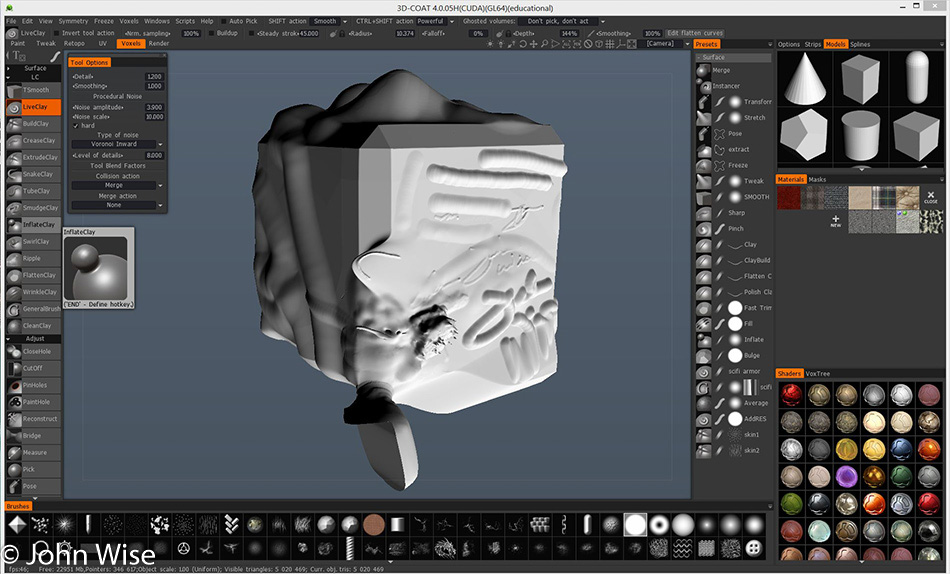We have many a path to consider when the road forks and we need to take on a new direction. So it is as we head into Virtual Reality, and the tools we will use are not set in stone. None of us know for certain what the face of VR is going to look like, although we can conjecture that it will look a lot like today, only different. Okay, I anticipate that it will be really different. Like the potential to be out of this world crazy different. The only problem is that for something to be seen that way, there must be a “normal” to compare it to. But before we get to blow the minds of the uninitiated, we have to build the foundation of “normal.”
Today, we can choose to develop “worlds” from a wide variety of tools ranging from Unreal Engine, CryEngine, Unity, and dozens of other environments to the private engines employed within companies that are used by them exclusively. Along the way, we will learn about textures and materials and how Substance Designer, Photoshop, Gimp, nDo and dDo, Lightroom, and our digital cameras will be needed to paint these places we assemble. Before we ever get to those images, we will also have to decide on which 3D modeling software we are going to take up, such as Blender, Modo, 3DS Max, Maya, Softimage, Houdini, C4D, or a couple of others. Just learning to think in x,y, and z coordinates is a monumental task by itself.
Gaming engines, image manipulation, 3D modeling, and we haven’t even touched on motion capture, puppeteering, animation, sound design, audio editing, or writing and designing a place others might want to visit.
So why not make it simple and just choose a single skill set and focus on being an expert in one area? Because those days are coming to an end.
Forty years ago as the personal computer revolution was getting underway, a small class of the curious sequestered themselves in a corner of their home and started to learn how a computer might be helpful to themselves and maybe to others. The process was slow and laborious; we either learned to code or manually entered instructions as they had been printed out in the back of a magazine. Fifteen years later someone could make good money entering data or typing documents. That industry has since shifted, and no one in Western society is rewarded for being an expert in a word processor or a spreadsheet alone. Ten years after that, in 1998, if you had mad Photoshop skills, you could make bank creating graphics for an up-and-coming internet property. Today, designers often struggle to find work where Photoshop by itself will give them viable employment. Ask any coder/programmer when the last year being knowledgeable in a single language was enough to land them a six-figure income.
The evolutionary writing is on the proverbial cave wall for many; writ large, it says, “Thou shall not gain credibility or a decent job in the next economy without being a master of the suite.”
This “Suite” is an assembly of tools, probably of your choosing, that says, “I have skills that are flexible, and I can demonstrate an ability to adapt.”
And why do I believe this? Because after much of humanity automates itself into a lack of purpose, we will have to ask ourselves, “What else is there?” The only conceivable answer is we must entertain ourselves. If Virtual Reality is the environment we are going to explore as the interface to that entertainment, well, that space is infinitely large. To fill the space of infinity, we will embark on creating “stuff” to play with, to explore, and to give us purpose again.
In effect, we will all become farmers again, except the crops are digital assets that feed the mind. A new agrarian age in which we cultivate the electronic landscape, bringing us full circle to a previous time when the majority of us tilled the land. Except now, we will work the soil of creativity by employing Ableton or Bitwig to sequence our beats and sounds. You’ll pop open Blender to knock out some 3D furniture or 3D-Coat to sculpt up some creatures. Connect the motion capture data from your Xbox Kinect to a digital skeleton and bring that dancing blob of pixels to life in your retro-future-psychedelic-historic-dystopian-sci-fi city on the internet. Maybe a multi-story gallery dedicated to your family will be erected in your new cyberspace environment that will display a living family tree of photos and videos that forever tell the story of the Smith family. Well, you are going to have to be the one to break out Premiere, After Effects, Reaper, Photoshop, and Unity to put it all together – just as your parents shot video on bulky cameras and your grandparents pasted black and white photos into albums.
It’s time to “Get it!” Complexity and adaptability are the order of the day. We no longer tinker in isolation on computers barely faster than a modern watch. We no longer become experts in typing documents. Photoshopping is now a hobby, not a career (by itself, anyway). If there are 1000 people out there mastering a dozen really difficult pieces of software, tomorrow, it will be all of us.
